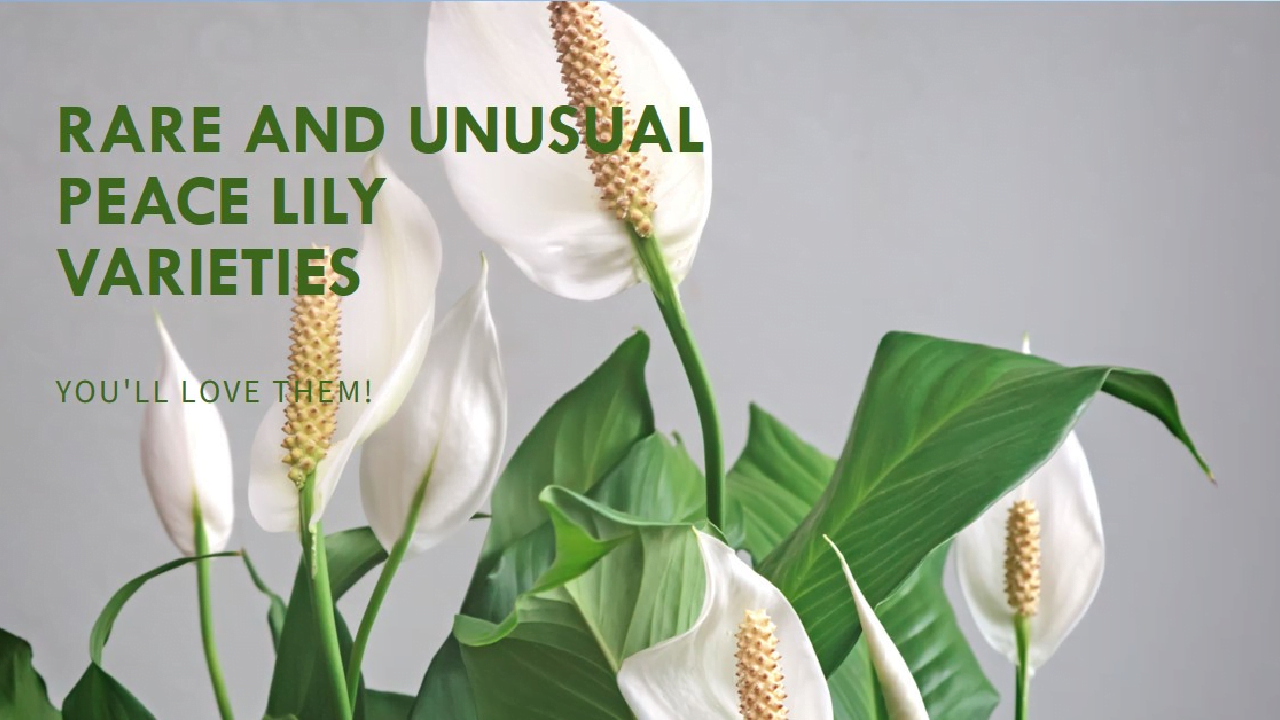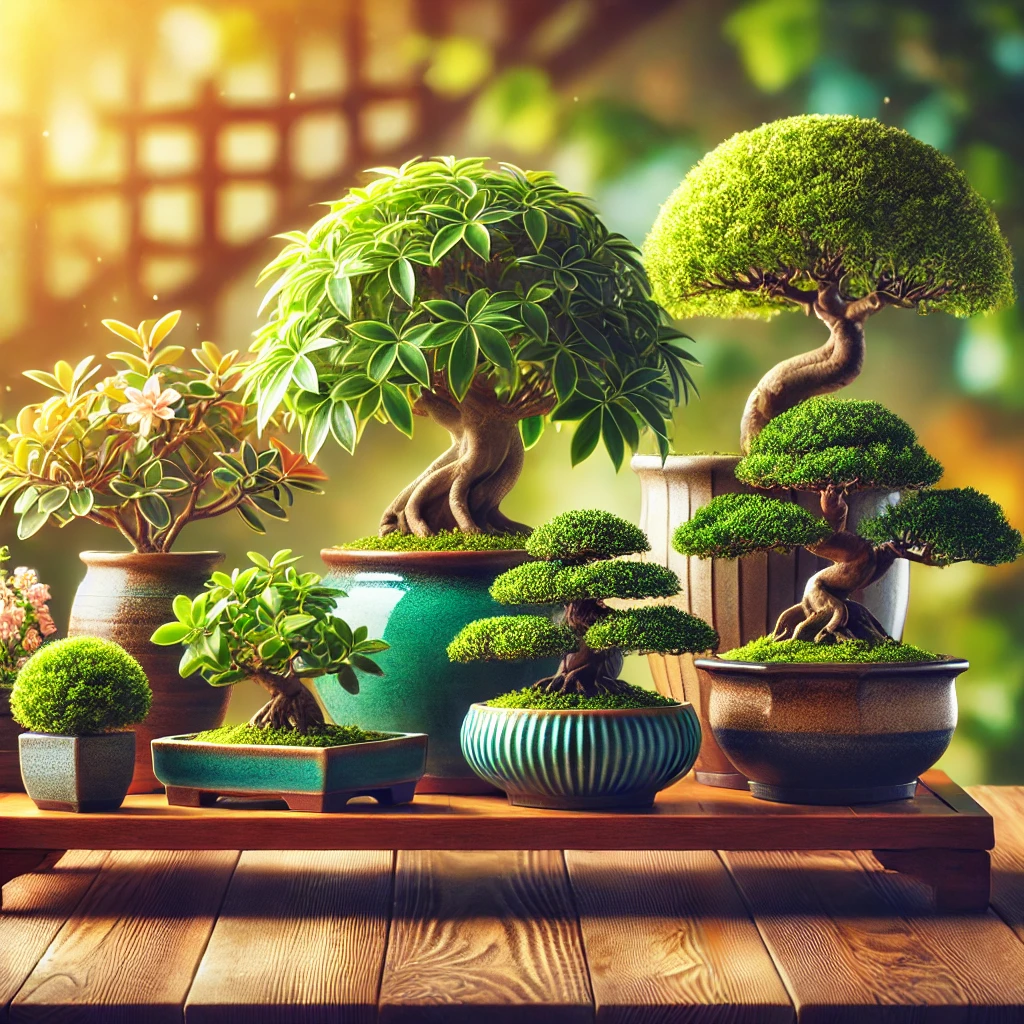If you are a plant lover or starting a new journey with plants, peace lily definitely should be on your list, in fact, I think it should be your first choice. But one question that can confuse you is, ‘Which one to pick?’
I’m here to clear up your confusion. In this article, I will talk about over twenty peace lily varieties, both common and rare, that will surely ease up your confusion.
So, hop on to the journey of beauty and calmness as we explore the collection of peace lilies that will undoubtedly fill your senses with harmony in your home or office spaces.
Table of Contents
What is peace Lily and how to identify it?
The peace lily is a flowering plant from tropical regions and belongs to the Spathiphyllum genus. Don’t mistake it for the name, even though the name has ‘lily’ on it peace lilies aren’t real lilies. True lilies are from the Liliaceae family and peace lily is a member of Araceae.
Peace lilies usually produce flowers during spring, but a healthy plant can give flowers twice a year. Every flowering season stays for months. Peace lilies are slow to moderate growers and will take around two to three years to reach their mature size. Indoor peace lilies usually grow over sixteen inches, while outdoor plants can reach up to six feet in height.
Spathiphyllum has several distinct features that differentiate them from other plants and that’s why they are quite easy to identify. Just a quick glance at the leaves and flowers will help to categorize them:
Leaves: Peace lily’s leaves are long, oval, or lance-shaped emerging from the central rosette. They are vibrant dark green in color that is shiny.
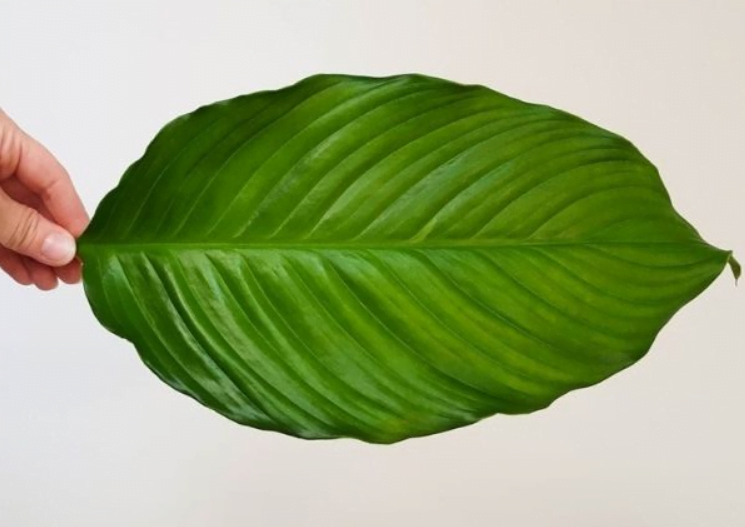
Flowers: The plant periodically produces distinctive white flowers. They are spoon-shaped and point upwards in thin stems. The shape also resembles the white flag, the renowned symbol of peace. Peace lilies are mildly fragrant as well.
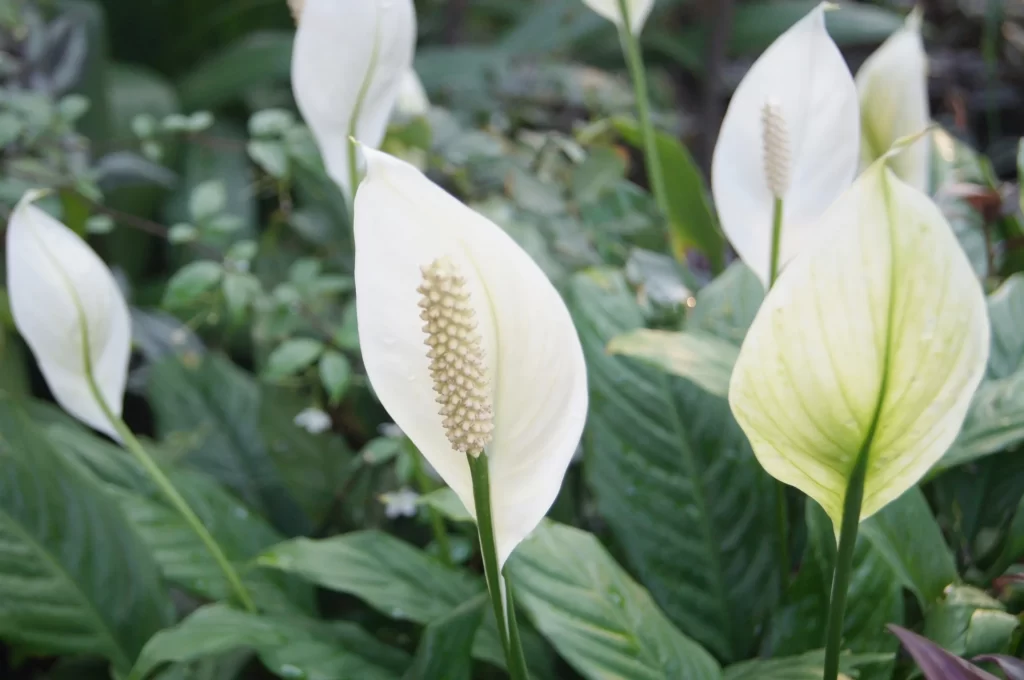
How many types of peace lilies are there?
There are approximately 47 different types of species and 100 types of unique varieties of peace lilies that exists on this earth. With keeping the base features, the range of the varieties differs in terms of height and variegations.
Types of peace Lily
1. Spathiphyllum wallisii
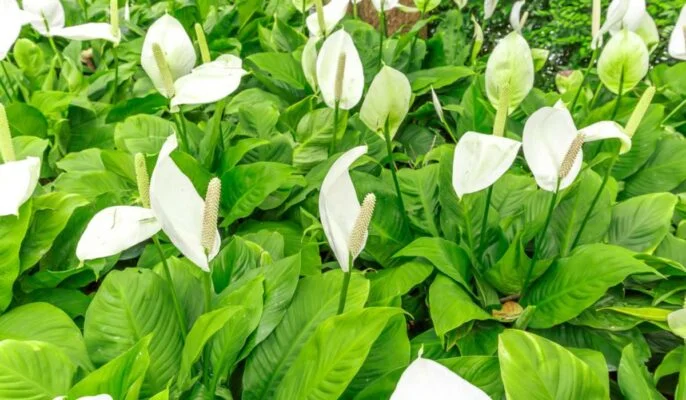
Botanical name: Spathiphyllum wallisii
The Wallisii Peace Lily is a dwarf variety of peace lily, perfect for compact spaces. This exotic herbaceous plant is aboriginal to Peru, Colombia, and Ecuador. It can be characterized by its large white flower and yellow center that has a mild and sweet fragrance. The mature size Spathiphyllum Wallisii is around 40 cm in height, and 50 cm wide, and the spadix can reach up to 8 cm long. The Wallisii Peace Lily is named after French botanist Joseph Wallis.
Being from tropical regions they prefer moist soil and warm weather. Even though their tolerance level is not measurable, too much direct sunlight for too long will turn their leaves brown.
2. Sensation Peace Lily
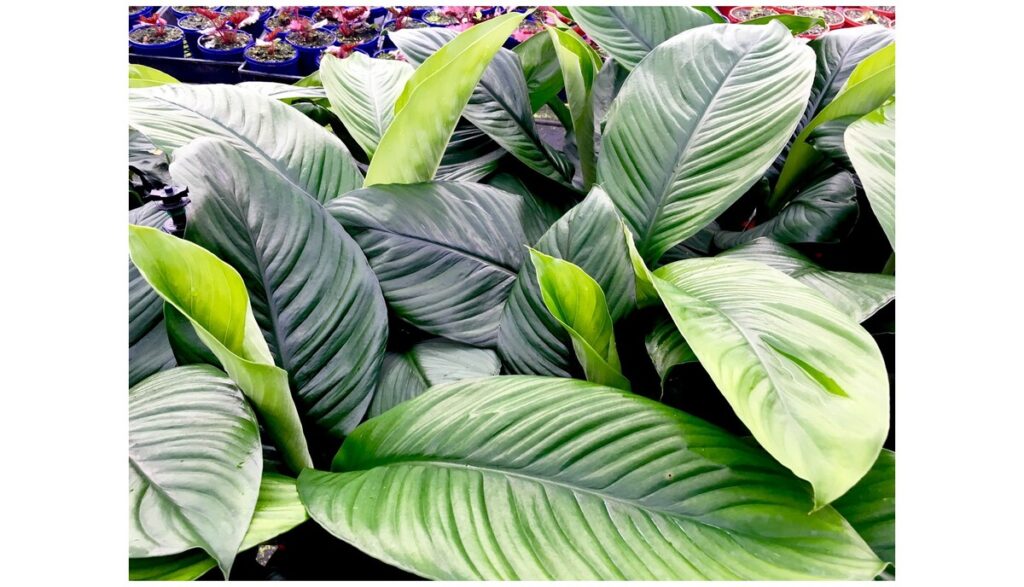
Botanical name: Spathiphyllum ‘Sensation’
The sensation peace lily is the largest type of peace lily. It features lush, large, deep green leaves that grow in layer formation. It has long-lasting white flowers that grow from tall stakes and reaches up to 50cm in its mature phase. Upon reaching maturity the plant can get over one metre tall.
These plants are best for the living room as a statement piece.
3. Cannifolium Peace Lily
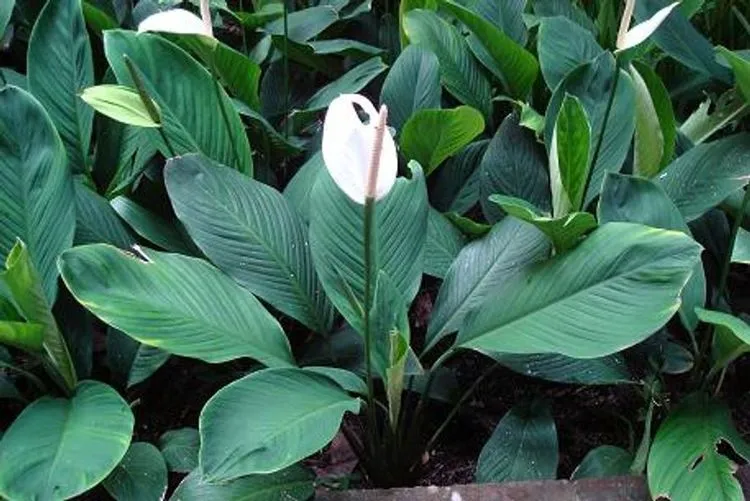
Botanical name: Spathiphyllum Cannifolium
Also known as ‘The Canna-Leaf Peace Lily’ Cannifolium Peace Lily, is an evergreen plant that grows in a cluster shape and can reach up to 50 cm tall and about 60 to 90 cm wide upon reaching its prime age.
They are one of the larger species with large and shiny oval-shaped leaves and have a dark green color with defined veins, that looks like canna leaves.
The flowers of the Cannifolium Peace Lily
are arranged in a long, thin structured spadix, and they are creamy white in color. The spadix is attached by a larger, pale yellow colored spathe, which folds backward and exposes the spadix. They initially came from the tropical areas of America, but now it is grown all over the world as a houseplant.
4. Peace Lily Domino

Botanical name: Spathiphyllum ‘Domino’
Spathiphyllum ‘Domino’ is characterized by its lance-shaped large leaves with white spotty variegations. This is one of the larger types of peace lilies and the color contrasts of the leaves make it exceptional from others. Those leaves can spread outwards from the pot and they can spread up to 60cm wide. The plant itself can grow around ninety cm in height in its mature state. The cone-shaped white flowers can reach over fifteen cm in length and stay for months. Because of their variegation, they require more sunlight than non-variegated types and can make a perfect outdoor plant, but they are shade-tolerant.
5. Jetty Peace Lily
Botanical name: Spathiphyllum ‘Jetty’
Jetty peace plants are widely famous because they are evergreen perennials and are known for their tolerating personality in challenging circumstances. They are characterized by dark, sheen leaves and white flowers with yellow centers. Jetty peace lilies can produce more flowers than other Spathiphyllum varieties. They are fast-growing herbs and can reach up to twenty-four inches.
6. Power Petite Peace Lily
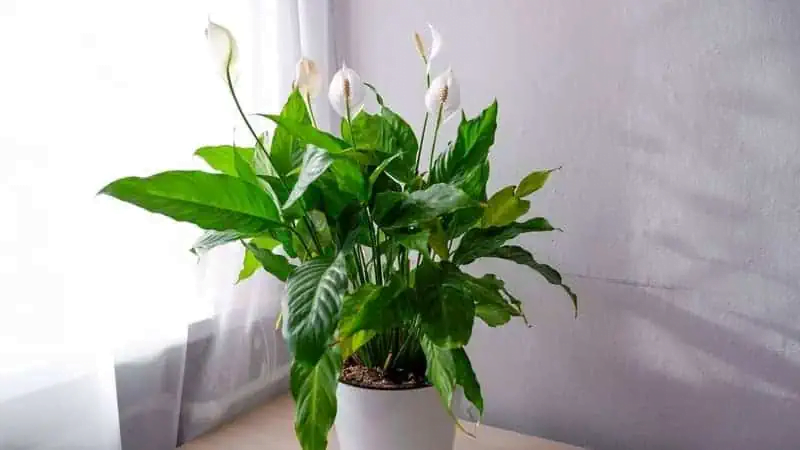
Botanical name: Spathiphyllum ‘Power Petite’
The Power Petite Peace Lily, also known as Spathiphyllum ‘Power Petite’, as the name suggested is a compact type of peace lily that is easy to take care of and has beautiful leaves. It’s perfect for those who have smaller indoor spaces.
Spathiphyllum ‘Power Petite’ Peace lily enjoys partial or indirect sunlight. They particularly enjoy warm and humid conditions, so they are cozy and environment-friendly.
The Power Petite Peace Lily has dark green leaves that are oval-shaped and sheen. The leaves grow close together, creating a compact look. It can reach a height of about 30 cm and spread out up to 25 cm upon reaching its mature state.
What makes petite peace lilies unique from others is that they produce flowers in every season.
7. Piccolino Peace Lily
Botanical name: Spathiphyllum ‘Piccolino’
The Piccolino Peace Lily is a small version tropical houseplant. It is categorized by its deep green oval-shaped leaves and small white flowers. Their flowering season lasts almost the whole year. Its petite form is perfect feet as a tabletop plant. Its highest range of height and width is 10 and 12 inches. A little bit of water and occasional pruning is sufficient to keep it looking nice.
8. Little Angel Peace Lily

Botanical name: Spathiphyllum ‘Little Angel’
You can say little angel peace lily is a scaled-down version of common peace lilies with its extra delicate leaves and flowers. This plant’s features are categorized by its compact size, oval white and green variegated leaves, and tiny flowers with yellow centers emerging in between the leaves, making them look like a perfectly arranged bouquet.
The plant itself can’t grow more than twelve inches and the flower three inches, is ideal to keep them over a shelf or table.
9. Mauna Loa Supreme Peace Lily
Botanical name: Spathiphyllum ‘Mauna Loa Supreme’
The Peace Lily ‘Mauna Loa’ is a beautiful plant known for its exceptional features. It is categorized by Its large, extended leaves that can get more than one foot. The leaves are pointed upwards and curve outward at the tips. The flower stem of this plant can extend up to twenty inches long and produces a single piece of creamy-white or greenish flower.
The foliage and overall shape of the Peace Lily ‘Mauna Loa’ are almost the same as the hosta plant. What makes this variety unique is its flower. Each flower has a finger-like big spadix, surrounded by a large petal-like leaf. These blooms stand above the foliage on stems without leaves. The snowy white flowers are long-lasting and slowly turn green as they age. While the plant can produce flowers throughout the year, it tends to flower most prominently from winter to summer.
10. Bongo Bongo Peace Lily
Botanical name: Spathiphyllum ‘Bongo Bongo’
Bongo Bongo Peace Lily is a giant peace lily that is slightly smaller than the largest varieties of peace lily, the sensation peace lily. It has a distinctive and exotic appearance with its dark green leaves with white vines. Its flowers are long-lasting but a bit smaller than the other varieties of peace lily. They require constant watering and indirect light to be in their healthiest form.
11. Spathiphyllum ‘Allison’
Botanical name: Spathiphyllum ‘Allison’
Allison peace lily is native to South America and Columbia. They are medium-sized plants and have glossy, slim leaves. The flowers of this Lily look identical to calla lilies and they have a white, hood-like covering that looks similar to a white ‘surrender’ flag.
This particular Lily is low-maintenance and grows quickly. It despises direct sunlight, so it’s better to keep it in a shade or somewhere it can get indirect light. If you determine to plant it outdoors, you’ll need to bring it indoors during the winter as they don’t do well in harsh winters too. During the winter, the Allison Peace Lily produces creamy white flowers that arise from the leaves.
12. Spathiphyllum ‘Golden’
Botanical name: Spathiphyllum ‘Golden’
A rare and unique indoor flowering plant, the ‘Golden’ peace lily is highly valued for its capability to purify indoor air. What makes this plant unique among peace lilies are its snake-like flowers. If you closely observe the leaves, you’ll notice that they are shiny and glossy, without the spathes. They have a tint of golden color. Young flowers are slightly green in color while the mature ones are white. The highest height they can reach is nine inches and the width of six inches.
13. Spathiphyllum ‘Mojo’
Botanical name: Spathiphyllum ‘Mojo’
Spathiphyllum ‘Mojo’ is a carefree plant that produces a lot of flowers. You can keep them indoors in a pot or in a frost-free garden. What makes distinctive mojo from other peace lily varieties is the tall and slander feature. The flowers grow at the end of tall stems, making them easily visible. These plants grow in clumped formations and are native to South America.
14. Spathiphyllum ‘Sweet Rocco’
Botanical name: Spathiphyllum ‘Sweet Rocco’
Spathiphyllum ‘Sweet Rocco’ is one of the newest types of peace lily. Spathiphyllum ‘Sweet Rocco’ is a lovely plant with shiny, green leaves and creamy-white lily flowers. Those flowers last long.
Spathiphyllum ‘Sweet Rocco’ grow in clump formation and their easygoing mentality makes them perfect for homes without sunlight reach. This particular type is known for being a great air purifier. In fact, it was ranked among the top plants for cleaning the air in NASA’s plant study. Spathiphyllum ‘Sweet Rocco’ can tolerate different conditions, but it prefers humid environments.
15. Spathiphyllum ‘Patricia’
Botanical name: Spathiphyllum ‘Patricia’
The ‘Patricia’ peace lily is a small plant featuring green leaves and white flowers that have light yellow colored centers. The combination of white, yellow, and deep green creates a soothing and delicate look for indoor spaces. Just remember that this variety may not have very full leaves, so if you want a plant that looks bushy and full, just go for a different type. Mature size plant’s highest reach is twelve inches.
16. Cupido Peace Lily
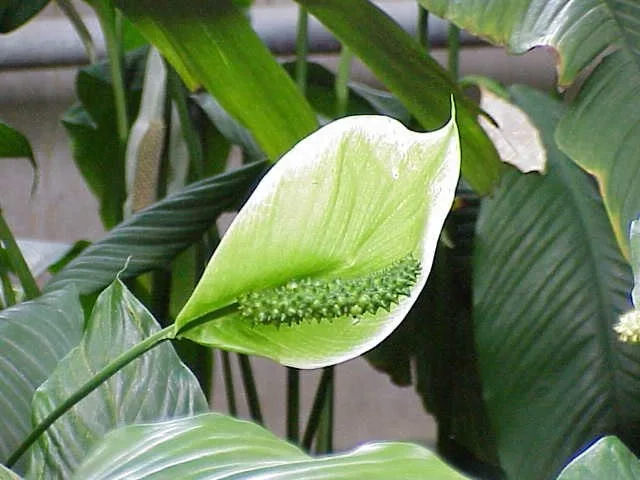
Botanical name: Spathiphyllum Cochlearispathum
The Cupido Peace Lily will catch the attention with its lance-shaped, dark-green, glossy foliage. The plant itself has the potential to reach a height of sixty-five cm and can spread around twenty-five cm upon reaching its maturity. The flowers are oval-shaped and are usually eighteen cm long and six cm wide. The spadix is about 5-10 cm long.
17. Snowflower Peace Lily

Botanical name: Spathiphyllum Floribundum
Snow flower peace lilies have oval-shaped leaves with long-pointed tips. They became popular houseplants because they can live in low light and with minimum care. The mature leaf of a snow flower peace lily is about twenty-five cm long and twelve cm wide. Snow flower peace lily has the ability to tolerate various atmospheres but loves partial bright light and moist soil.
18. White Stripe Peace Lily
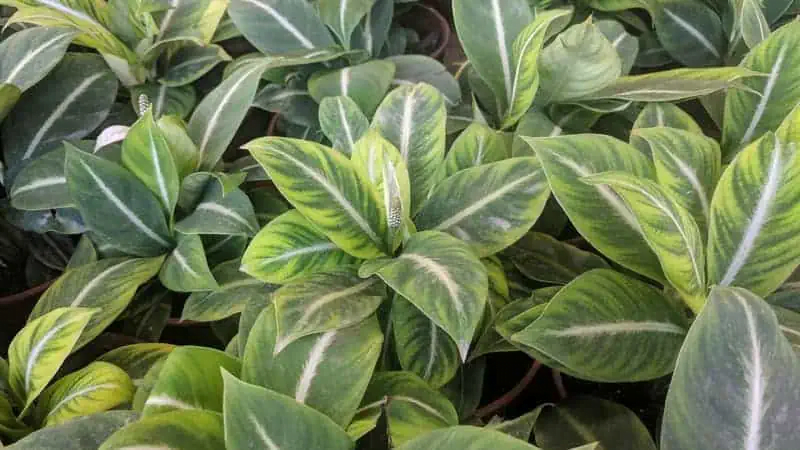
Botanical name: Spathiphyllum ‘White Stripe’
White stripe peace lily has some similar features to other varieties of peace lily, but it possessed one unique feature as well. Their foliage is dark green with distinctive white stripes in the midrib section. The silvery bold stripes are an eye-catching feature of this particular plant and that’s why it’s also known as white lightning or silver strikes. This variation is particularly popular for its unique looks.
19. “Clevelandii” Peace Lily
Botanical name: Spathiphyllum ‘Clevelandii’
The Clevelandii Peace Lily is a cool variant plant that is categorized by dark and shiny leaves that are shaped like lances and grow in ribbon formation. The leaves alone can grow really long (eighteen inches). But what really really attracts me are the big white flowers.
When the flower blooms, the Spathe acts like a protective cover, has a slight curve and it has the creamy white spadix inside. In tropical areas, the Clevelandii Peace Lily can grow more than 2 meters tall and wide, but the indoor plant’s highest reach is half a meter. Overall The Clevelandii Peace Lily’s appearance is dramatic.
20. Peace Lily “Savanaah”
Botanical name: Spathiphyllum ‘Savanaah’
Peace Lily Savanaah is a plant that originally comes from South America and Peru. It catches attention because of its deep green leaves that are shaped like arrowheads.
The leaves of this Peace Lily have a dense and matte color, which is different compared to other types of Peace Lily as most peace lily leaves are sheen. They also have shallow ribs and a wide arching shape.
Some additional types of peace lilies
Here are some honorable mentions that I love but could not make it to the real list.
Spathiphyllum Platinum Mist
Botanical name: Spathiphyllum Wallisi ‘Platinum Mist’
The combination of their beautiful white flowers and green foliage makes them a centerpiece in interior design and a great deal for people who prioritize aesthetics. When the Peace Lily Platinum Mist blooms, you’ll get multiple flowers that even last for a few months.
Spathiphyllum Blue Moon
Botanical name: Spathiphyllum ‘blue moon
Blue moon peace lilies are medium in size and have dark green leaves that are carved at the end. They originated from tropical parts of South America and that’s why they love hot and humid weather.
The plant has a unique and exotic formation with its slender leaves and white flowers. The leaves are large and green, and outdoor plants can grow more than three feet tall.
Picasso Peace Lily
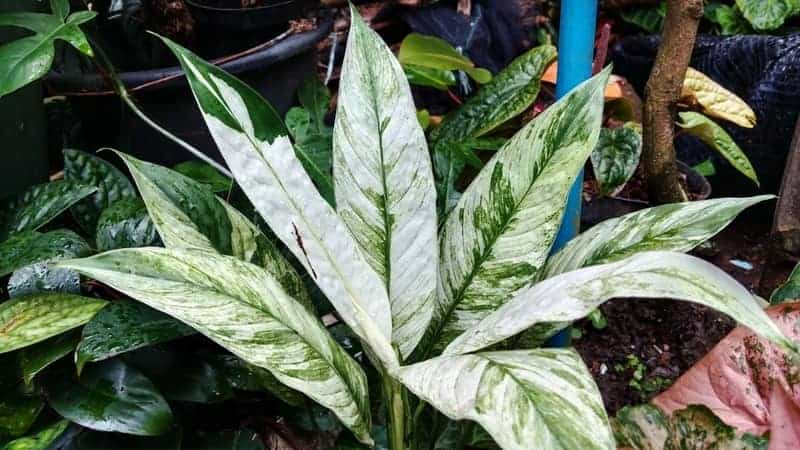
Botanical name: Spathiphyllum ‘Picasso’
Picasso peace lilies are considered one of the rarest types of peace lily. Yet it is popular because of its unique variegated leaves. Its special kind of foliage has a green base with white stripes all over it. Other than that their characteristics are similar to other varieties of peace lilies.
Peace lily care tips
Peace lilies are tropical evergreen plants and are easy to care for. Here are some proven care tips, if followed you will enjoy its healthy blooming seasons:
Sunlight: Place your plant beside an east-facing window, where it can get eight to twelve hours of indirect sunlight. Both indoor and outdoor peace lily, love bright and indirect light. They are known to flourish in low-light states but will create more irregular spathe buds and will have a looser growth pattern.
Water: They enjoy good moisture, but can’t stand clogged water. Wait for the soil to dry out a bit before watering. The usual water frequency is once a week. Peace lilies would instead be under-watered rather than overwatered. The dose of water your plants will require relies on the height and depth of your pot and the drainage abilities of the soil. As a general approach, water just when the upper surface of the soil is dry.
Soil pH: Slightly acidic pH (5-6.5) level is what they like.
Soil type: Soil type: They are inclined to rot in saturated or damp soil situations but, strangely they can be cultivated in water alone. It’s easier for the roots to get oxygen from the water than clogged soil. If you like to raise your peace lily in water, the peak of the plant should sit further than the waterline to stop the rot. Peace lilies need a rich, quick-draining potting mixture or compost to flourish.
Humidity: Peace lilies love moisture in the air. They thrive in humidity levels of 60 percent or above.
Repotting: Repotting the plant every few years is good practice. Repotting is essential if the roots come out from the drainage hole. Use a slightly bigger than the recent pot to avoid giving them a shock.
Fertilizer:
Peace lilies do fine with the periodic dosage of a slow-release fertilizer but don’t go overboard with the application. Limit feedings to once a month throughout the spring and summer and keep an eye out for yellowing or browning in the leaves. Over-fertilization makes peace lilies inclined to leaf burn which is also called fertilizer burn. If you are developing a peace lily in water independently, you can add some liquid fertilizer to the water every two weeks to fulfill its soil nutrients.
Pruning:
Peace lilies do great from frequent pruning and deadheading. After a branch has created a “flower”, it will not create another one and will ultimately turn brown and fail. Prune back stalks like this at the bottom of the plant to make space for fresh stalks. Then, prune out yellow or shriveled leaves and spathe buds with sterilized shears.
Conclusion
Appearance wise most peace lily varieties are almost similar. But all of them are slightly different from each other, some are differentiated by their size, and some by the amount of flowers they can produce, and there are rare types with variegated leaves. No matter what kind it is, the care is easy. So, you should at least get one type from the list and grace your indoor.
FAQs
Q1. Can peace lilies grow in any home?
You don’t have to be an expert gardener to cultivate peace lilies, most peace lily species are low-maintenance and don’t really mind where they are placed. However, some peace lily varieties like Spathiphyllum ‘Sensation’, and Spathiphyllum ‘Bongo Bongo’ can get huge in size so you need to consider the size of your apartment before bringing them in.
Q2. What peace lily prefers shade or sun?
Peace Lily prefers partial sun for eight to ten hours a day, but they can tolerate any light condition.
Q3. What peace lily varieties are toxic for pets?
Almost all plants are from the Araceae or arum family is toxic. All peace lily varieties are toxic as well. But the level of toxicity is mild.
Q4. What is the rarest peace lily?
The Picasso Peace Lily is a very special and rarest variety of peace lily. What makes it so unique is its beautiful leaf variegation, which looks like strokes of paint. This special characteristic makes them stand out from all the other types of spathiphyllum.
Q5. What is the biggest peace lily?
The ‘Sensation’ peace lily is the biggest kind you can find. It can grow really tall, reaching heights of 4 to 6 feet, and it can also spread out in the same wide.
Q6. What is the ideal location for peace lily?
In the wild, peace lilies flourish on the woodland floor—so they worship moist climates and mottled sunlight. Consider setting yours in a washroom that is decorated by a solar tube or skylight or near a north or east-facing window. Avoid putting your peace lily in harsh sunlight as the intense rays can burn the plant’s leaves. If light choices are limited in your house, a peace lily can nonetheless thrive in low-light situations. Just be aware that when developed with little light exposure, peace lilies are less likely to create their lovely flower-like bracts.
Related Articles
- How to Choose the Perfect FRP Planter for Your Indoor Spaces
- Signup & Login to Abana Homes
- The Ultimate Guide to Buying Bonsai Plants: What to Look for and Where to Buy
- Boost Your Garden’s Health: 5 Key Reasons to Start Mulching Today
- Propagating Chinese Elm Bonsai Cuttings And From Seeds
- Best Chinese Elm Bonsai Soil and Fertilizer.

